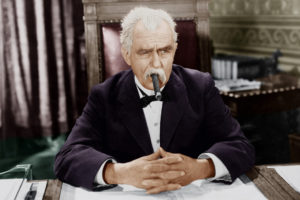He drives on the wrong side of the stock market
“Right, now turn left”, I command.
“What left?”, she said.
“No the other left, which is right”, I replied.
My wife is learning to drive. For some bizarre reason she thinks I can teach her, forgetting the fact that I learnt in the UK, where they drive on the left.
Here in Zürich, I’m frequently asked: “Why do you drive on the ‘wrong’ side of the road”.
I don’t take offence. I find it quite funny. But I now have a well-crafted answer, just for this occasion, so here it is.
Britain (the wrong side)
In the olden days in ancient Britain, chivalrous men – let’s call them knights – carried swords and rode their horses on the left side of the road. They were able to draw their swords with their right hand and defend themselves under attack.
They could also greet a passerby with an unarmed right-hand as an act of reassurance that they weren’t going to attack them.
This is where we get the modern-day handshake, which is usually done with our right-hand. Overall, it was meant to be a pragmatic right-handed solution in ancient times for greeting and defending oneself.
This is why Brits sit on the right and drive on the left.

The United States (The right side)
Things started out differently in another English-speaking country – the US.
In pre-independent colonial times, there were no knights galloping around with swords. There were, however, hardworking colonists who drove heavily ladened carts pulled by large oxen.
On the front seat, the driver would have to sit on the left so he could whip the rear of the beast with his right hand. This meant they had to drive on the right to greet passersby and also avoid collisions. This same tradition evolved in France after the French Revolution and then Napoleon exported this system after he almost conquered the whole of Europe.
This is why Americans and most of Europe, sit on the left and drive on the right.

What’s interesting is that driving is not about being right, wrong or left. Two completely different systems evolved for the same reason: most of us are right-handed and greet one another with our right hand.
I’ve driven on both sides of the road for years (not at the same time). I made the move when I move from the UK to Switzerland and neither is better than the other. You just get used to it.
These different systems evolved for different reasons due to the environment people lived in at the time. It shaped their view of the world and their perception of how it should work.
However, the consensus view can be horribly wrong.
For centuries, mercury was used as a healthcare product, even though it was lethal. A mixture of economic hardship and social upheaval lead to the Nazi party coming to power in the 1930s. And more recently, the catastrophic collapse of the subprime mortgage market in the US occurred after the mistaken assumption that risk was better managed, by spreading it out.

The asset management a huge range of investment styles and philosophies have evolved which work for different reason. Different systems have evolved, depending on the environment we’ve been in.
Right now, there appears to be the beginnings of a shift. Investors are starting to move away from passive to active investing. Buying the index for the last 10 years has been cheap as everything has risen under quantitative easing and very low interest rates.
But now stock market valuations might seem lofty in a rising interest rate environment. If there is a correction, understanding a stock’s fundamentals, might present a better way to manage risk than waiting for volatility to pick up.
However, I’m cautious about labelling one approach “right” and one “wrong”. And I don’t want to declare that “he” – the investor – drives on the wrong side of the stock market.
There are many way to look at risk and you can construct an index in a very active way. Ultimately, investors need to pick the best route that gets them where they want to go, and that depends on how long the journey is, and how much they want to see along the way.











